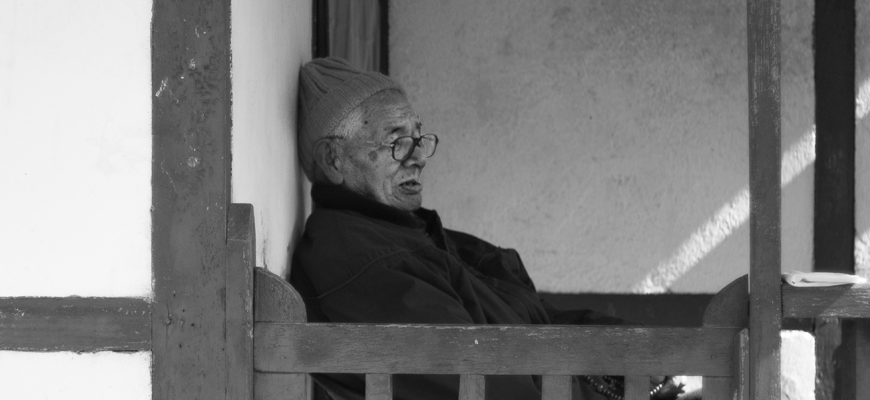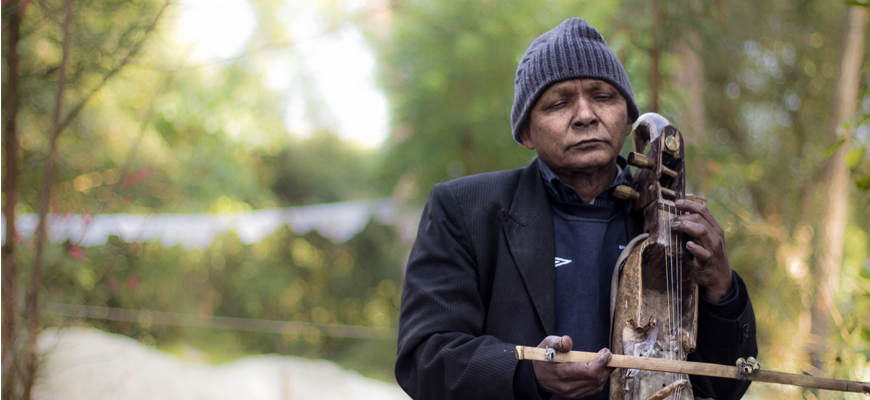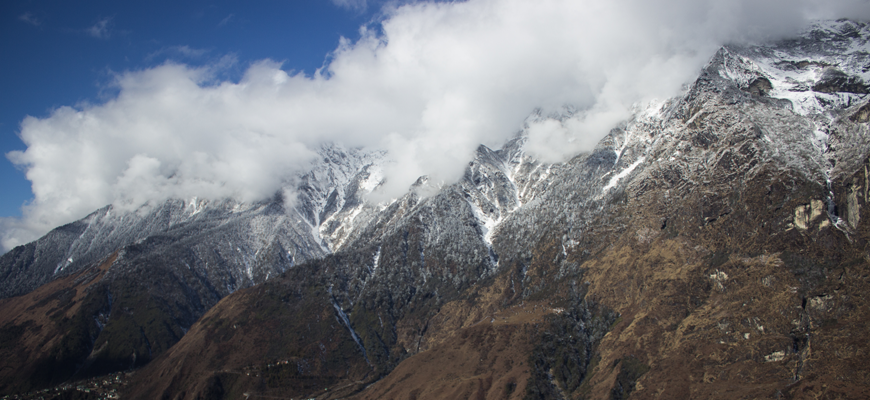It had been quite some time that I had been dreaming of a journey to Sikkim. I had discussed it with many of my friends. Most of them seemed really interested to join me; but as is the case with most people, they had way too many difficulties standing in the way of a trip like this. I guess that’s how it is normally. Someone who travels alone can take off anytime, without waiting for anyone else. It’s when you try to plan a trip with others that you keep putting it off. That’s how I decided to become a solo traveller.
When you travel alone, it is very important that you have a basic idea of the places you wish to visit, accommodation facilities available, the routes you need to take and so on. I did my homework and collected as much information as I could from websites like the Official Web Portal of Sikkim Tourism, traveltriangle.com etc.
January 22, 2016 – The big day! – My first destination was the capital of Sikkim, Gangtok. Coming under the Eastern Himalayan region, Gangtok is the largest town in Sikkim, situated at an elevation of 5,410ft and having a population of more than 1,00,000 inhabitants. The nearest airport is at Bagdogra. My flight, which took off at 10:45 in the morning from Bangalore, landed at the small airport of Bagdogra by around 3 in the evening. Gangtok is 120 kilometers far from there by road. Hatchbacks from the airport charge you 2,100 rupees for this trip. Around 12 kilometers from the airport is a place called Siliguri. I had read that shared jeeps are available to Gangtok from Siliguri and felt that was the best way. I was about to start for Siliguri when I met a couple of young Hotel Management students who were travelling to their campus at a place called Rumtek, quite close to Gangtok. We decided to travel together in a car and booked one from the airport. At around 4 in the evening, we finally started our journey to Gangtok.
Our driver kept speaking to us in Hindi peppered with Nepali words. I watched in amazement as we sped past beautiful tea plantations on one side. Dashing forth on the other side was the majestic river, Teesta, looking gorgeous in mesmerizing shades of blue and green. The view was way more stunning than what I had seen in pictures. An inexpressible mixture of feelings kept churning in my mind – the awe and excitement at the sight of places I had been dying to see for so long, and a tinge of anxiety of travelling alone on an alien terrain.
Chattering non-stop, cracking jokes and stopping by to have tea once in a while, we had a very pleasant journey indeed. By 8 at night, we dropped them at Rumtek and went on to our destination. It’s strange how you meet some people, hardly for some hours on a journey sometimes, and become friends with them even when there is no certainty that you will ever meet them again. I guess that’s life! We all travel on separate paths, join each other at some junction once in a while, and then move on.

I reached my hotel at around 9. It was pretty cold with the temperature at 4 degree Celsius. After having my dinner from the hotel’s restaurant, I went to my room. My plan was to roam around Gangtok city and see everything there was to see. It would cost me 1,300 rupees to have someone take me around the town for one whole day. I was told that this was a lower rate as it was not the peak season. During the peak season that starts from March, the rate shoots up to around 2,500 rupees. I went to bed after setting the alarm for 7 in the morning.
I woke up sharp at 7 to a typical chilly winter morning. It was difficult to even rinse properly after brushing because my teeth kept chattering. I took a bath somehow, had my breakfast and waited for my cab, which picked me up by 9. The first point we wanted to reach was a Buddhist monastery in Rumtek, somewhere close to where my friends from the day before had gone.
Driving on the picturesque roads for an hour, we reached the monastery by 10. The monastery is guarded by the army. You cannot enter without an identity proof of some kind. This Tibetan Buddhist monastery was built in the 1700s by the twelfth lama, Changchub Dorje. A huge idol of Sri Buddha exuding magnificence can be seen inside the monastery. Attached to the monastery, there is a college for Buddhist studies. A handsome young boy in a monk’s robe I came across over there, reminded me of the character, Unnikuttan from the 90’s Malayalam classic, Yodha. I showed him the picture I took of him in my camera and was rewarded with an innocent smile.
From there we travelled to another monastery called Enchey. Situated 3 kilometres north-east to Gangtok, this monastery is 200 years old. I saw Buddhist monks and devotees circling the monastery, offering prayers. Right by the monastery is an imposing dome-shaped shrine or Stupa called Do Drul Chorten, built in the year 1945. Close to the monastery is a Tibetan museum called Namgyal. The collection of ancient coins and palm-tree manuscripts (Thaaliyola grantham) in the museum is immense.
Our next stop was at a flower show nearby. I had been to flower shows in Lal Bagh at Bangalore so many times before. But for the first time, here, I was dumbstruck by the sheer beauty of the enormous number of flowers, a lot of them which I was seeing for the first time. Myriads of exquisite flower decorations made me gasp at the pure magic they created.

I decided to spend the evening at M. G. Road. The ambience there was soothing – beautiful people wearing beautiful clothes walking on neatly tiled roads. In one corner, I could see a gathering of people singing and dancing and making merry. What struck me was the joy in the air, probably because of the closeness I felt in the people. No one seemed to have an inhibition in having fun with others. I would have stayed on there for hours if it was not for the freezing cold penetrating my jacket and making me shiver. I had my dinner and got back to my room by 10.
Nathula was my destination for the next day – a charming mountain pass at the Indo-China border. You need an entry permit to enter the pass. I had given two photographs and my identity card to the hotel manager and arranged for the permit already. Tourist vehicles are not permitted at the pass after 10 in the morning. I knew we had to start early. Having set the alarm for 6, I went to sleep.
I was ready and waiting by 7 in the morning. Parthan, my driver, arrived soon enough and we started out on an adventurous journey on the dangerous roads where smaller cars were not allowed. All through the drive, Parthan kept talking to me about Sikkim, Gangtok, his family, his Malayali friends and a lot more. He asked me if I was married and I said no. I could not help laughing when he replied, “Very good decision, Sir”.
At around 8:30 AM, we reached an army check post where the entry permits were being checked. There was a long line of vehicles. I got out of the car and walked around a bit. I could see an army vehicle coming from the distance. When they reached where I was, they got out and started collecting water from a small waterfall. I walked towards them. It is said that you will find a Malayali at every corner of the world. That turned out to be true as not just one, but both the soldiers were Keralites. I asked them if they were from Kerala. They seemed quite happy to meet someone from their homeland and came to me immediately. We talked for some time. They even offered me some of the popcorn they were having. I could see people from other vehicles watching me chat with the soldiers. I must say, I felt proud. When the checking was finally done, I said good bye to them and walked back to my car with my head held high.
On the way, we could see army camps here and there. Parthan told me that these were strategic locations in the 1962 Indo-China war. It got colder as we kept twisting and turning on the roads, with snow all along the sides. A lake called Tshangu was our first halt here. It was frozen all over and I could only see ice everywhere around me. I stood there taking in the beauty and watching mothers scolding their kids for running on the ice, yaks taking tourists across the frozen lake, army vehicles with snow chains in place. A soldier informed us that Nathula pass was closed due to snowfall. Realizing there was no use sticking around; we started back to Gangtok by noon. On our way back, I stopped at a temple called Hanuman Tok. From the top of the temple, I could see Kanchenjunga, the highest mountain in India, and the third highest in the world. We got back to Gangtok by 3 in the afternoon.

I had nothing else to do in the evening and so decided to walk around M. G. Road with my camera. There was an exhibition and sale of traditional food items nearby. I ate from there and walked on until I reached a marketplace called Lal Bazaar. It was a market known for vegetables and groceries. Beautiful girls selling vegetables sat here and there, waiting for customers. I noticed that the marketplace was maintained very well and it looked really clean. I roamed around at M. G. Road and nearby places all the evening and got back to my hotel by 9. My journey for the third day was planned to a place called Lachung in north-east Sikkim. Three tourists from Kolkata, who were staying in my hotel, had also decided to join me. I met them, fixed 9 in the morning as the time to start and went to bed.
It was 10am by the time we had started from Gangtok in a Tata Sumo. There were eight people in all, including some from nearby hotels. We had to pay 1,500 rupees per person for the travel and the accommodation that would be provided. Lachung, situated at an elevation of 8,600ft from sea level, is a small town at the border of India and Tibet, 125 kilometres away from Gangtok. We moved slowly on roads filled with potholes. We reached our destination by 6 in the evening. At -6 degree Celsius, with a light snowfall, it was freezing there. Adorned with rivers, snow-capped peaks, roads blanketed with snow and little wooden cottages, Lachung looked stunning. The long day of a not very comfortable road trip had left us exhausted. Thankfully, we hadn’t planned anything for the evening. We had an early dinner and went to our rooms right away. We couldn’t afford to stay up late anyway as we had to start our next day’s journey at 5 in the morning. I was shivering slightly with cold even after I sandwiched myself between two mattresses. I guess the exhaustion was stronger than the cold and off I went to sleep in no time.
By 4 in the morning, everyone was up. The temperature had dropped to -12 degree Celsius. We started our slow drive to Katao, 28 kilometres away from Lachung. We had to cross an army check post to enter Katao. Through the white veil of snowfall we could see snow atop the Himalayan mountain peaks glistening in the early morning sun rays. Here and there we could see frozen lakes and rivers. I felt that this was nature at its best. We drove past yaks moving along the roadside slowly.
From Katao we went on to a valley called Yumthang. Enveloped by Himalayan range, this valley of flowers is at an elevation of 11,693ft from sea level. The valley lies asleep under snow from December to March. In spring, flowers of every kind bloom covering the valley in vibrant colours. Teesta River starts its slow journey around the valley yet again. My fellow passengers were busy writing names of the ones they love on the fallen snow.
We got back to Lachung by noon, had our lunch and then started back on our long journey to Gangtok. By the time we reached Gangtok at 9, all we wanted to do was hit the sack. After a forced dinner, I crashed into bed for a long, dreamless night. I had one more day in town and I had seen everything I wanted to see already. So I didn’t bother to set the alarm.

It was after 9 that I opened my eyes, feeling fresh after the uninterrupted sleep. After getting ready, I went first to the Himalayan Zoological Park. It has been maintained as a natural ecosystem where various kinds of birds and animals dwell in acres of forestland. Red panda and long-haired mountain cats found only in the Himalayas are among some of the unique sights you can expect here. By noon I decided to get back to Gangtok and spend the rest of the day with my camera, doing what I like the best – walking around and clicking pictures.
On my way back I sat in the shade near a Buddhist monastery. An artist was playing an instrument which looked like the violin. I sat listening to the heavenly music. When I got up to leave, he sang the song “Pardesi pardesi” so beautifully that I felt my eyes welling up. The rest of the evening, I walked aimlessly all over M. G. Road.
The twilight had vanished into the fog – my last night in the town of Gangtok. I lay on my bed, holding all the memories close to my heart. I am going to miss the chill in the air so badly tomorrow. Why did I take so long to come here? With countless memories for a lifetime – of the wonderful places, of the wonderful people – I was returning to Kolkata. I knew I had to wake up early. I hugged my pillow tight and drifted off to sleep, enjoying the cool air under the blanket for one last time. Good night!
About the Author
Dipu is an Engineer by profession and a Photographer by passion. He loves travelling alone to capture people, life and culture.